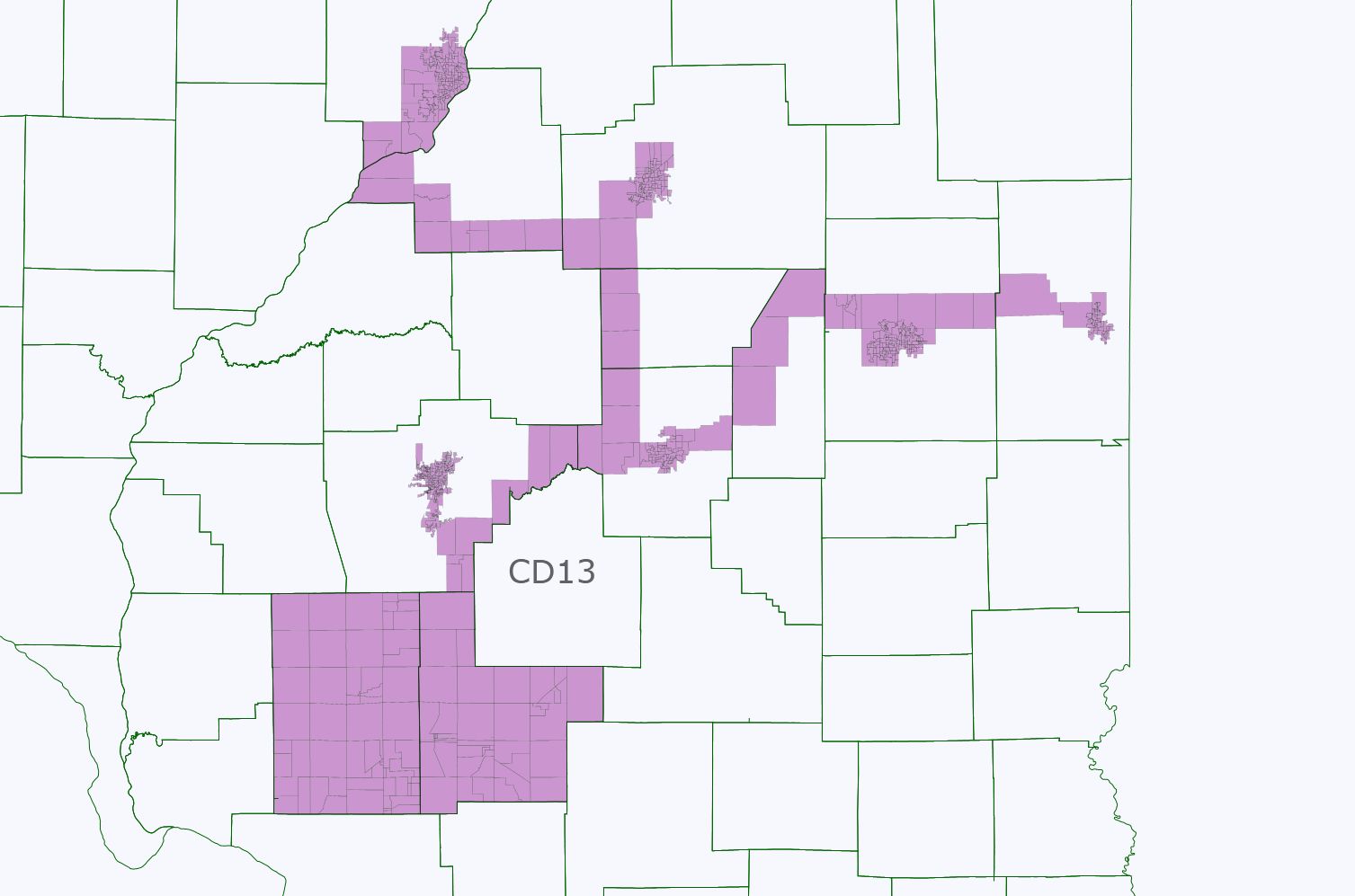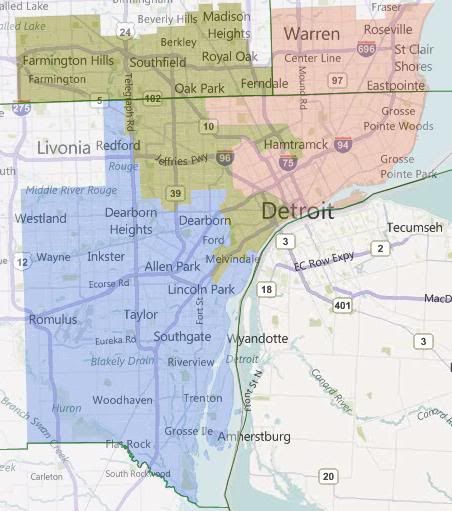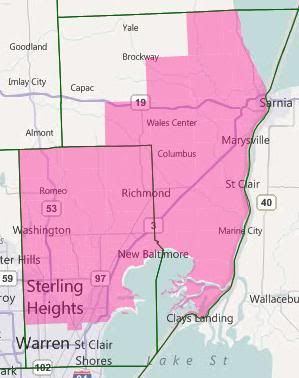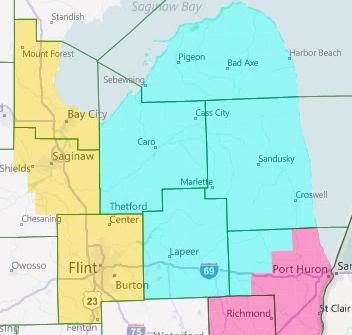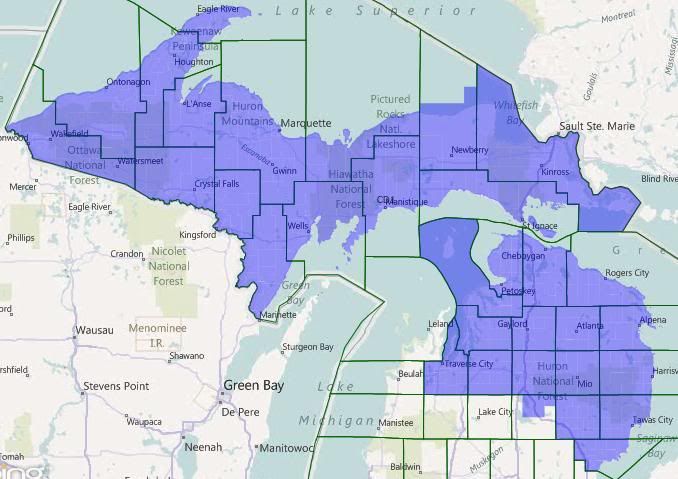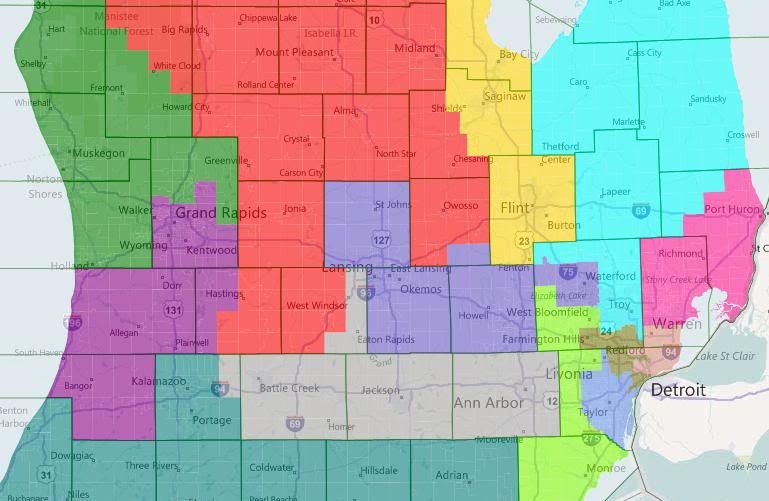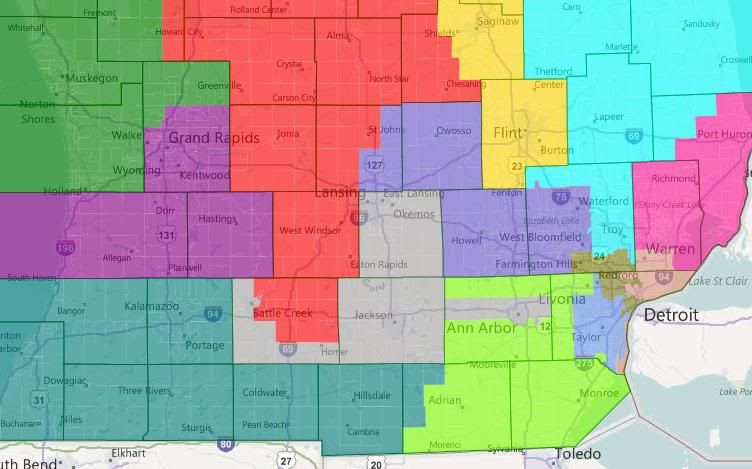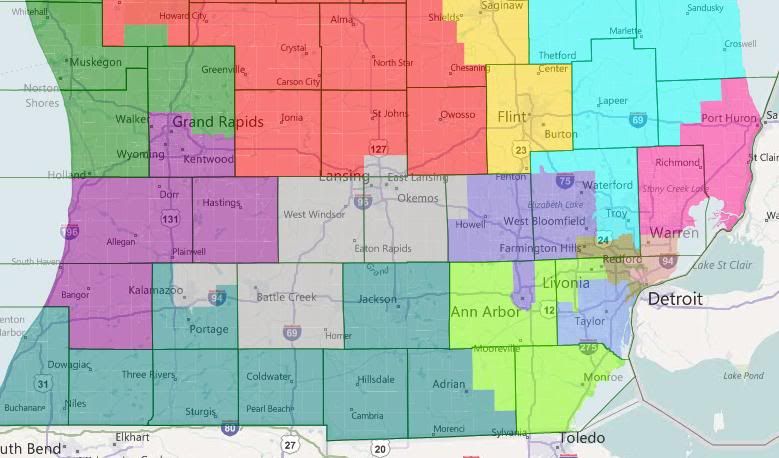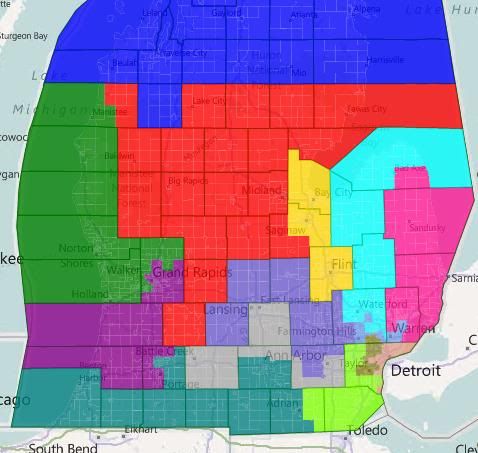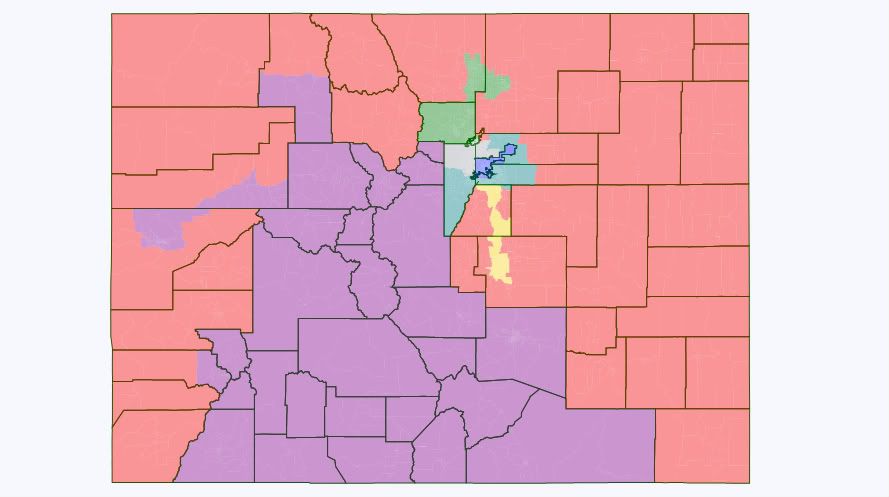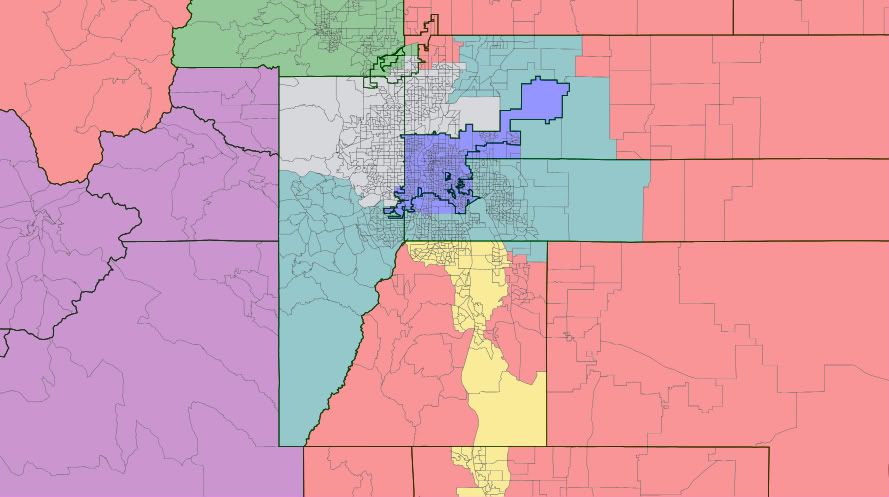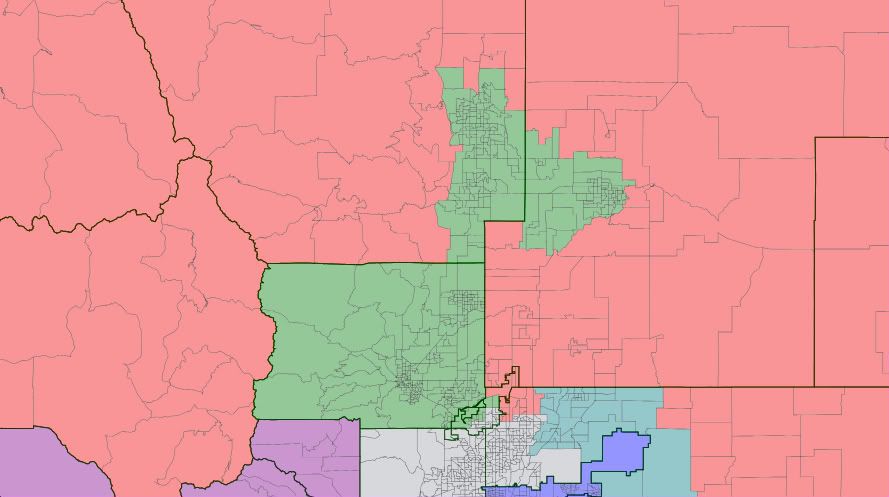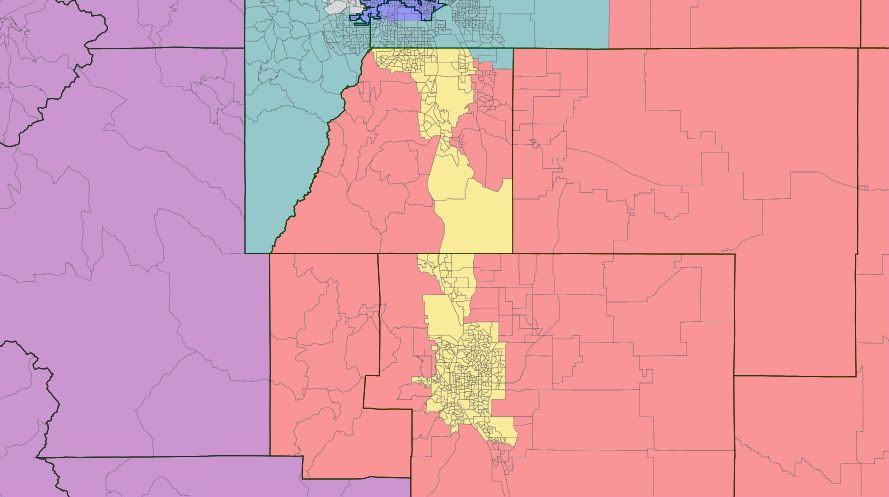The Democrats begin this process with a clear disadvantage from previous redistricting. Following the Cook Partisan Voting Index there are:
194 D+ seats
9 EVEN seats
232 R+ seats
We can not forget it.
This diary seeks to give a preview about what the Republicans can do in the redistricting process and about the best ways for the Democrats in certain states (IL, MD, AR, WV, OR, CO, NY…) to have some success after the current redistricting process.
The diary is focused to see the most direct potential or likely effects of the redistricting process.
STATES WITH FULL CONTROL FOR THE REPUBLICANS
I’m not optimistic about this group of states because the Republicans never lose a chance for take advantage. The Republicans will have full control of the redistricting process in many states, and I will go state by state.
Utah
One new district for the Republicans.
UT-02 J Matheson (D) surely will run in a R+20+ the next time and without part of the current basis that send him to the house now.
Wyoming
No effect.
Oklahoma
OK-02 D Boren (D) surely will run in a R+20+ district. The same as J Matheson.
Alabama
No chance for B Bright to return.
Alaska
The Alaska Redistricting Board (Commission) is in Republican hands.
No changes.
Nebraska
NE-02 will be surely safer for the Republicans. There is no chance Obama wins again this electoral vote.
Kansas
KS-03 safer for the Republicans.
Louisiana
Thanks to some party switches, the Republicans have control of both state chambers and because of this they will have control of the redistricting process. But Louisiana will lose one seat and that cannot be LA-02 thanks to the Voting Rights Act. That means the Republicans will lose one district here.
No chance for C Melancon to return.
LA-03 seems the district that would disappear.
North Dakota
No effect.
Texas
Here I do not expect gains for the Democrats. As a maximum, one if we recover TX-23 and TX-27, but I think it is very difficult. If there are not a law requiring the creation of new VRA districts, the Republicans will create none. Finally, there are 36 districts for Texas, I would expect 7 D+, 3 R+low approximately and 26R+10 or higher, but things still can be worse. The three “swing” districts can likely be the successors of TX-28, TX-27 and TX-23. These would be again the districts to fight.
Four new districts for the Republicans.
TX-25 L Doggett (D) can likely run in a R+10+ district or against one of the neighboring democratic incumbents.
TX-28 H Cuellar (D) can likely run in a R+low district.
South Dakota
No effect.
Tennessee
No chance for L Davis to return.
TN-05 J Cooper (D) can likely run in a R+10+ district. The same as L Doggett.
South Carolina
One new district for the Republicans.
No chance for J Spratt to return.
Georgia
If I’m not wrong the Republicans can decrease the percentage of African-Americans in GA-02 and GA-12 because there are districts with a white majority (over 50% white) and would have less VRA protection. That means these will be new R+ districts.
One new district for the Republicans.
No chance for J Marshall to return.
GA-02 S Bishop (D) can likely run in a R+10+ district.
GA-12 J Barrow (D) can likely run in a R+10+ district.
Indiana
If the Republicans wish they can draw all the districts with R+6 rating. If they keep one Democratic seat (likely IN-01), they can draw all the other districts with R+8 rating. If they keep two Democratic seats (likely IN-01 and IN-07), they can draw all the other districts with R+10 rating. Looking at the recent history of IN-08 and IN-09 districts, I think they will want the safest seats, so I think they will keep IN-01 and IN-07 as Democratic seats.
IN-02 J Donnelly (D) will need to run for a R+10+ district or will need to run a primary against P Visclosky.
North Carolina
The Republicans have full control of the redistricting process here. They will take advantage of this, but North Carolina is a swing state with a strong tradition of moderate to conservative Democrats. The most competitive district that the Republicans won in 2008 was R+11. First they need to protect NC-02. And later I think they will bid to make NC-08, NC-07 and NC-11 enough Republican to try to defeat the Democratic incumbents. It is more likely they will go after these seats because the Democrats here can be more dangerous for them for statewide races. NC-01, NC-12, NC-13 and NC-04 would keep D+ rating. NC-01 in the North East, NC-12 in Charlotte, NC-13 in Raleigh-Durham, and NC-04 in the area of Fayetteville toward Chapel Hil toward Greensboro. D Price may get out his NC-04.
NC-08 L Kissell (D) can likely run in a R+10+ district.
NC-07 M McIntyre (D) can likely run in a R+10+ district.
NC-11 H Shuler (D) can likely run in a R+10+ district.
Florida
The current redistricting of Florida is very pro-Republican and the new procedure for redistricting will not change it. All the current swing districts are in Republican hands and the legislature (Republican majority) will not approve a map that does not protect their incumbents in 2012. FL-22 surely will become a R+low district. Florida will have some R+low districts that the Democrats can fight for.
Two new R+ seats for the Republicans.
Ohio
Despite having full control of the redistricting process, including the trifecta and the commissions that draw the legislative maps, the Republicans do not have a chance of improving in Ohio. The Republicans have enough work to keep the incumbents, including their gains of 2010 (5 seats) and surely it will not be possible they win more. They will lose at least one district, and they will have a lot of swing districts with R+low rating, including OH-01, OH-12 and OH-15.
OH-13 B Sutton (D) surely will get out of the game.
One Republican seat will disappear too. Maybe OH-06.
New Hampshire
No changes.
Pennsylvania
The Republicans control the Pennsylvania Legislative Reapportionment Commission that draws the state legislative districts and the state legislature that draws the congressional map. But redistricting Pennsylvania is more difficult than Ohio for the Republicans. They have enough work protecting incumbents, and they will have a lot of swing districts with R+low rating. I expect 5 D+ safe districts (PA-01, PA-02, PA-13, PA-14 and PA-17). T Holden does not seem vulnerable and surely the Republicans will give to his district a D+ rating. PA-11, PA-06, PA-07, PA-08 and PA-15 can be R+ low in 2012. And here there are two Democratic incumbents in R+ districts that can have trouble.
PA-12 M Critz (D) surely will be without his own district and surely will need to run against a Republican incumbent, but the district will likely have R+low rating.
PA-04 J Altmire (D) will likely run in a R+10+ district.
Wisconsin
After winning full control of the redistricting process, I think the Republicans will work to keep their incumbents in 2012. Surely WI-07 will be a R+low district. Because of it, all the Republican incumbents will be in swing districts. The recall can affect the process giving, some chance to the Democrats.
Michigan
Again the same. The Republicans have more than enough work keeping their incumbents, and surely MI-06 and MI-11 will end as R+low districts. Michigan must lose one district and will likely be MI-09.
MI-09 G Peeters (D) can likely get out the game. Surely G Peeters will need to run against other incumbent, maybe against S Levin (D).
RECOUNT
+22 new R+ districts
-18 new D+ or EVEN districts
We have the next range for the Republican gains after redistricting:
+1 – +2 Utah (1 new and maybe UT-02)
=0 – =0 Wyoming
=0 – +1 Oklahoma (maybe OK-02)
=0 – =0 Alabama
=0 – =0 Alaska
=0 – =0 Nebraska
=0 – =0 Kansas
– 1 – – 1 Louisiana (1 seat less LA-03)
=0 – =0 North Dakota
+4 – +6 Texas * (4 new and maybe TX-25 and TX-28)
=0 – =0 South Dakota
=0 – +1 Tennessee (maybe TN-05)
+1 – +1 South Carolina (1 new)
+1 – +3 Georgia (1 new and maybe GA-02 and GA-12)
=0 – +1 Indiana (maybe IN-02)
=0 – +3 North Carolina (maybe NC-08 and NC-11)
+2 – +2 Florida * (2 new seats)
– 1 – – 1 Ohio * (1 seat less OH-06)
=0 – =0 New Hampshire *
=0 – +1 Pennsylvania * (maybe PA-04)
=0 – =0 Wisconsin *
=0 – =0 Michigan *
———–
+7 – +19 Total Republican gains for these states *
And the range for the Democratic gains after redistricting:
– 1 – =0 Utah (maybe UT-02)
=0 – =0 Wyoming
– 1 – =0 Oklahoma (maybe OK-02)
=0 – =0 Alabama
=0 – =0 Alaska
=0 – =0 Nebraska
=0 – =0 Kansas
=0 – =0 Louisiana
=0 – =0 North Dakota
– 2 – =0 Texas * (maybe lose TX-25 and TX-28)
=0 – =0 South Dakota
– 1 – =0 Tennessee (maybe TN-05)
=0 – =0 South Carolina
– 2 – =0 Georgia (maybe GA-02 and GA-12)
– 1 – =0 Indiana (maybe IN-02)
– 3 – =0 North Carolina (maybe NC-08 and NC-11)
=0 – =0 Florida *
– 1 – – 1 Ohio * (1 seat less OH-13)
=0 – =0 New Hampshire *
– 2 – – 1 Pennsylvania * (1 seat less PA-12 and maybe PA-04)
=0 – =0 Wisconsin *
– 1 – – 1 Michigan * (1 seat less MI-09)
———–
– 15 – – 3 Total Democratic gains for these states *
* = This diary looks at the most likely direct effects of the redistricting. I have not counted the swing districts that are not strongly affected by the redistricting process and that the democrats can win in Texas, Florida, Ohio, New Hampshire, Pennsylvania, Wisconsin and Michigan in 2012, despite the Republican full control of the redistricting process in these states. The effect of this would be fewer gains to the Republicans and would be fewer losses for the Democrats (maybe some net gain).
STATES WITH BIPARTISAN OR INDEPENDENT COMMISSIONS AND STATES WITH CONTROL OF BOTH PARTIES
COMMISSION
Idaho (R majority ID Supreme Court)
No effect. Maybe ID-01 be a little more Republican.
Montana (D majority MT Supreme Court)
No effect.
Arizona (R majority AZ Supreme Court)
Arizona will win one house seat that can go to the Republicans and in exchange the Democrats will seek to protect AZ-08 until they have a D+5+ district.
New district for the Republicans.
Iowa (R majority IA Supreme Court)
Iowa will lose one seat. Yesterday was published the first draft of the Commission for redistricting. I think the first map will be rejected. Two of the current incumbents must run at least in the same district. Likely one Democrat and one Republican but the rest would keep their own district. Surely the most likely option is L Boswell (D) and T Latham running in something like a merger of the current IA-03 and IA-04 that can be very close to EVEN rating. I would not accept anything worse. Surely a merger of the current IA-01 and IA-04 would be more favorable for the Democrats but the Republicans would reject this.
New Jersey (D majority NJ Supreme Court)
The commission in this state is keeping one of the most pro-Republican maps in all the bluest states. This year the prospect is favorable because the Democrats are a little favored in the control of the process for drawing new maps, but still the final map can keep pro-Republican details. The state will lose one US House seat and the first candidate can be NJ-03 if they are not open seats. It seems none of the Republican representatives would challenge R Menendez before losing his US House seat in the redistricting process. Later surely the damaged Republican will challenge him. I think NJ-02 can become also R+.
Maine (D majority ME Supreme Court)
Maybe ME-02 becomes a little safer.
Washington (D majority WA Supreme Court)
There will be a new district likely in the north of King County that can go Democratic, while WA-03 can be R+low district, but WA-08 would countinue as D+low. I hope WA-02 also becomes a little safer district, while other Democratic seats do not get weaker.
California (R majority CA Supreme Court)
I’m so skeptical about the result of the new system for redistricting California. I think we have lost an opportunity of drawing a good map having the trifecta (the governor and the majority in both state chambers). At least, CA-11 should become a D+ district, but the redistricting in California is the most unpredictable process (with Texas), and we can have surprises here.
New York (R majority NY Court of Appeals but D CJ)
The first goal for the Democrats must be up to D+5+ level NY-02, NY-27, NY-01 and NY-23. NY-25 surely will be the first district that gets out the game. The Democratic votes of Syracuse can help making safer the NY-23. Still I think the Democrats must find more here. I think the Democratic members of the legislature must want the Republicans to lose a second seat. I would select NY-13, but if there is some trouble about Staten Island, the next option would be NY-03. This still would leave 6 R+low swing districts in New York. This is little improvement. I think the little advantage of the Republicans in the state senate should not be enough to stop these improvements and maybe more.
Vermont (D majority VT Supreme Court but R CJ)
No effect.
Hawaii (D majority HI Supreme Court but R CJ)
No effect.
RECOUNT
– 2 new R+ districts
=0 new D+ or EVEN districts
We have the next range for the Republican gains after redistricting:
=0 – =0 Idaho
=0 – =0 Montana
+1 – +1 Arizona * (1 new seat)
– 1 – =0 Iowa (maybe lose the current IA-04)
– 1 – – 1 New Jersey * (1 seat less)
=0 – =0 Maine
=0 – =0 Washington *
=0 – =0 California *
– 2 – – 2 New York * (2 seats less)
=0 – =0 Vermont
=0 – =0 Hawaii
———-
– 3 – – 2 Total Republican gains for these states *
And the range for the Democratic gains after redistricting:
=0 – =0 Idaho
=0 – =0 Montana
=0 – =0 Arizona *
– 1 – =0 Iowa (maybe lose the current IA-03)
=0 – =0 New Jersey *
=0 – =0 Maine
+1 – +1 Washington * (1 new seat)
=0 – =0 California *
=0 – =0 New York *
=0 – =0 Vermont
=0 – =0 Hawaii
———–
=0 – +1 Total Democratic gains for these states *
* = This diary looks at the most likely direct effects of the redistictring. I have not counted the swing districts that are not strongly affected by the redistricting process and that the democrats can win in Arizona, New Jersey, Washington, California, and New York in 2012, despite the Republican full control of the redistricting process in these states. The effect of this would be fewer gains to the Republicans and would be fewer losses for the Democrats (maybe some net gain).
Some people think the “independent” commissions are the right procedure for redistricting, but the Republicans have an advantage here because these commissions keep some pro-Republican maps and contribute to the advantage that the Republicans have in other states where they work with full control.
In the R+ states working with commissions, the Democrats only have 2 Hispanic representatives in Hispanic majority districts, and 1 (G Giffords) in a R+ district. While, in the EVEN or D+ states working with commissions, the Republicans have 39 representatives.
CONTROL OF BOTH PARTIES
Kentucky (R majority KY Supreme Court)
No important changes. The Republicans will block every improvement for the Democratic representatives.
Mississippi (R majority MS Supreme Court)
No changes.
No chance for T Childers or G Taylor to return.
Missouri (D majority MO Supreme Court but R CJ)
Missouri will lose one seat and that will give trouble to both parties. There are very few options for keeping the current MO-01 as an African-American majority district, so little discussion about the borders of this distric. For the rest, I think the most likely scenario can be a merger of MO-03 (D+7 R Carnahan) and MO-02 (R+9 T Akin) in a district that surely can not be EVEN, but can be R+1 approximately. Another option would be a merger of MO-05 (D+10 E Cleaver) and MO-06 (R+7 S Graves), but I think the Democrats will dislike losing the balance between St Louis and Kansas City and the Republicans will dislike leaving some Democratic votes to MO-04, endangering a second seat, or giving to the new seat from the merger a D+ rate.
MO-02/03 R Carnahan (D) can need to run in a R+1 seat against T Akin (R) if the Republican does not run for senate.
Virginia (R majority VA Supreme Court)
The Democrats will seek to protect VA-11 and the Republicans some of their districts. Still this state will have some swing district with R+low rating.
Colorado (D majority CO Supreme Court)
Here the Republicans have a very weak majority in the state house (32D-33R) but the redistricting is made by a commission where the Democrats can have the control thanks to the three members appointed by the governor, who has veto power. At a minimum I think the Democrats can be successful with a 3D-3R-1S map that gives EVEN or little better rating to the current CO-03. Nothing to lose here.
Nevada (D majority NV Supreme Court)
Nevada will have a new district. Surely NV-03 will be a R+low district while the new district will be a D+low.
Minnesota (R majority MN Supreme Court)
I think the Republicans can find MN-03 and MN-08 become R+ while the Democrats can find MN-01 and MN-07 become D+.
New Mexico (D majority NM Supreme Court)
Here I do not expect big changes. I think the Democrats can have some advantage making NM-02 a little less Republican.
Oregon (D majority OR Supreme Court)
I think the Democrats can be able to make safer OR-04 and OR-05. I would like to see a 5-0 map here and I think it would be possible. Despite the tie in the state house, the Republicans have a very weak prospect because if the state legislature fails drawing the maps, the Secretary of State (Democrat) would draw the maps of the state house and the state senate seats.
Connecticut (R majority CT Supreme Court)
The current map only needs a little mix of the current CT-05 and CT-01. A bipartisan commission will draw the paps that need the approval of 2/3 of both chambers. The Republicans are now just over 1/3 in both chambers.
RECOUNT
=0 new R+ districts
=0 new D+ or EVEN districts
We have the next range for the Republican gains after redistricting:
=0 – =0 Kentucky
=0 – =0 Mississippi
– 1 – =0 Missouri
=0 – =0 Virginia *
– 1 – =0 Colorado * (maybe lose CO-03)
=0 – =0 Nevada *
=0 – =0 Minnesota *
=0 – =0 New Mexico *
=0 – =0 Oregon
=0 – =0 Connecticut
———-
– 2 – =0 Total Republican gains for these states *
And the range for the Democratic gains after redistricting:
=0 – =0 Kentucky
=0 – =0 Mississippi
– 1 – =0 Missouri
=0 – =0 Virginia *
=0 – +1 Colorado * (maybe win CO-03)
+1 – +1 Nevada * (1 new seat)
=0 – =0 Minnesota *
=0 – =0 New Mexico *
=0 – =0 Oregon
=0 – =0 Connecticut
———–
=0 – +2 Total Democratic gains for these states *
* = This diary looks at the most likely direct effects of the redistictring. I have not counted the swing districts that are not strongly affected by the redistricting process and that the Democrats can win in Virginia, Colorado, Nevada, Minnesota and New Mexico in 2012, despite the Republican full control of the redistricting process in these states. Again, the effect of this would be fewer gains to the Republicans and would be fewer losses for the Democrats (maybe some net gain).
This would be the recount until now:
+20 new R+ house seats
– 18 new D+ or EVEN house seats
(+2,+17) range for Republican gains *
(- 15,=0) range for Democratic gains *
* = This diary looks at the most likely direct effects of the redistricting. I have not counted the swing districts that are not strongly affected by the redistricting process and that the Democrats can win in many states (emphasized with *). But the large majority of these districts would be R+low districts. That means the Republicans have some advantage here.
NH-01, NH-02, WA-08 and CO-03 are the only Republican districts in all these 43 states that surely would be EVEN or D+ after the redistricting process. The Republicans have a low chance of making or keeping these districts as R+, so these districts should be obvious targets for the Democrats in 2012 from now on.
STATES WITH FULL CONTROL FOR THE DEMOCRATS
From this group of states must come the improvements that balance the gains of the Republicans. I think the Democrats must find here the necessary gains to balance the Republican gains in other states. And just I will find it for this group (less to preview or predict and more to propose where is possible).
Arkansas
The Democrats have the control of the Board of Apportionment (Commission) that draws the state legislature districts and also control the state legislature that draws the congressional districts. The best way to keep the Democratic congressional delegation from Arkansas in the long-term would be to have a black district protected by the Voting Rights Act. Surely this is the last chance to make a black district in Arkansas protected by the VRA. If the Democrats from this state do not do this, the Republicans will have a 0D 4R map the first chance they have. It is possible to create a district with more African-American population than white, but for me the goal would be a D+ (D+5?) district that keeps the white population under 50%, to draw a R+5 district district for M Ross (including parts of Washington County, and to leave two R+20+ for the Republicans, approximately.
West Virginia
I think the Democrats will want to protect N Rahall (WV-03) and endanger WV-01. My goal would be both districts become R+5-. If it is necessary breaking the county borders.
Delaware
No effect.
Illinois
Illinois will lose a house seat too. The Democrats from Illinois surely can put every Republican incumbent running in a D+5+ district for 2012. I hope they do it. It is necessary. The redistricting in Illinois is key in this cycle for the Democratic Party for balancing the Republican gains in other states.
IL-06 seems the most likely district to disappear.
Maryland
I think the Democrats from Maryland will make MD-01 and MD-06 D+5+ districts, winning two seats for the Democratic side. The Democrats of the rest of the country need it to balance the Republican gains in other states.
Rhode Island
No effect.
Massachusetts
MA-10 W Keating (D) This state will lose one district after the redistricting process. I think we will not have open seats for 2012 here, and because of this MA-10 would be the most likely seat to disappear.
RECOUNT
– 3 to – 11 new R+ districts
+1 to +9 new D+ or EVEN districts
We have the next range for the Republican gains after redistricting:
– 1 – =0 Arkansas (maybe AR-02)
– 1 – =0 West Virginia
=0 – =0 Delaware
– 11 – – 1 Illinois
– 2 – =0 Maryland
=0 – =0 Rhode Island
=0 – =0 Massachusetts
———-
– 15 – – 1 Total Republican gains for these states *
And the range for the Democratic gains after redistricting:
=0 – +1 Arkansas (maybe AR-02)
=0 – +1 West Virginia
=0 – =0 Delaware
=0 – +10 Illinois
=0 – +2 Maryland
=0 – =0 Rhode Island
– 1 – – 1 Massachusetts
———–
– 1 – +13 Total Democratic gains for these states *
* = This diary looks at the most likely direct effects of the redistictring. I have not counted the swing districts that are not strongly affected by the redistricting process and that the Democrats can win in 2012. They are not in this group of states.
This would be the total recount without including the effect of a gerrymandered redistricting of Illinois:
+17 new R+ house seats
– 17 new D+ or EVEN house seats
183 D+ seats
3 EVEN seats (maybe IA-03/04, CO-03 and NH-01)
249 R+ seats
(- 3,+16) range for Republican gains *
(- 16,+3) range for Democratic gains *
This would be the total recount including the effect of a gerrymandered redistricting of Illinois:
+9 new R+ house seats
– 9 new D+ or EVEN house seats
191 D+ seats
3 EVEN seat (maybe IA-03/04, CO-03 and NH-01)
241 R+ seats
(- 13,+16) range for Republican gains *
(- 16,+13) range for Democratic gains *
* = This does not include many swing districts in Republican hands in many states (emphasized with *). But except NH-02, WA-08 and NH-01, all the other seats would be R+(low) districts. That means the Republicans have some advantage here.
California and Texas are the most difficult states to predict and can give the biggest surprises. California can give likely some good surprise, but Texas can give a likely worse result.
Gerrymandering Illinois can be the alone way to keep the current number of D+ seats in the US House and to balance the likely Republican gains that the redistricting process in other states will give to them.
——————————————————————————————-
——————————————————————————————-
RESUME
1 THE NEW DISTRICTS AND THE DISTRICTS TO DISAPPEAR
Republican safe gains = 10
UT-04 (new)
TX-33 (new)
TX-34 (new)
TX-35 (new)
TX-36 (new)
SC-07 (new)
GA-14 (new)
AZ-09 (new)
FL-26 (new)
FL-27 (new)
Democratic safe gains = 2
NV-04 (new)
WA-10 (new)
Republican safe losses that can not be Democratic gains = 6
LA-03 (disappear)
OH-06 (disappear)
IL-06 (disappear)
NJ-03 (disappear)
NY-25 (disappear)
NY-13 (disappear)
Democratic safe losses that can not be Republican gains = 4
OH-13 B Sutton (D) (disappear)
PA-12 M Critz (D) (disappear)
MI-09 G Peeters (D) (disappear)
MA-10 W Keating (D) (disappear)
In the middle = 2
MO-02/03
IA-03/04
From this group the Republicans will gain 2 to 4 seats (only 2 if L Boswell and R Carnahan can keep the districts).
2 THE DISTRICTS STRONGLY AFFECTED BY THE REDISTRICTING PROCESS
Democratic seats that can be Republican gains as a consequence of important changes in the redistricting process = 12
TX-25 L Doggett (D) as R+10+
IN-02 J Donnelly (D) as R+10+
GA-02 S Bishop (D) as R+10+
TN-05 J Cooper (D) as R+10+
NC-08 L Kissell (D) as R+10+
UT-02 J Matheson (D) as R+20+
GA-12 J Barrow (D) as R+10+
PA-04 J Altmire (D) as R+10+
NC-07 M McIntyre (D) as R+10+
NC-11 H Shuler (D) as R+10+
OK-02 D Boren (D) as R+20+
TX-28 H Cuellar (D) as R+low
Republican seats that can be Democratic gains as a consequence of important changes in the redistricting process = 15
MD-01 as D+5+
IL-08 as D+5+
MD-06 as D+5+
IL-14 as D+5+
CO-03 as EVEN
WV-01 as R+5-
AR-02 as D+5+
IL-17 as D+5+
IL-10 as D+6+
IL-11 as D+5+
IL-15 as D+5+
IL-19 as D+5+
IL-13 as D+5+
IL-16 as D+5+
IL-18 as D+5+
The order goes from the most vulnerable to the less vulnerable to the change for every party.
After the two groups the range for both parties (if Illinois is gerrymandered) would be:
(- 13,+16) range for Republican gains
(- 16,+13) range for Democratic gains
3 THE REST
Other Democratic endangered seats = 0
Only KY-06, WV-03 and AR-04 would have R+ rating.
Other Republican endangered seats = ?
Only NH-02, WA-08 and NH-01 would have D+ or EVEN rating.
A good number of swing R+low districts.
If the Democrats work well in group 2, other possible gains would help to reduce the Republican majority in the US House. If the Democrats do not work enough in group 2, some possible gains would help to balance the Republican advantage after the redistricting but not to gain new seats. It is very important to do a good work in the redistricting process.

Loading ...
